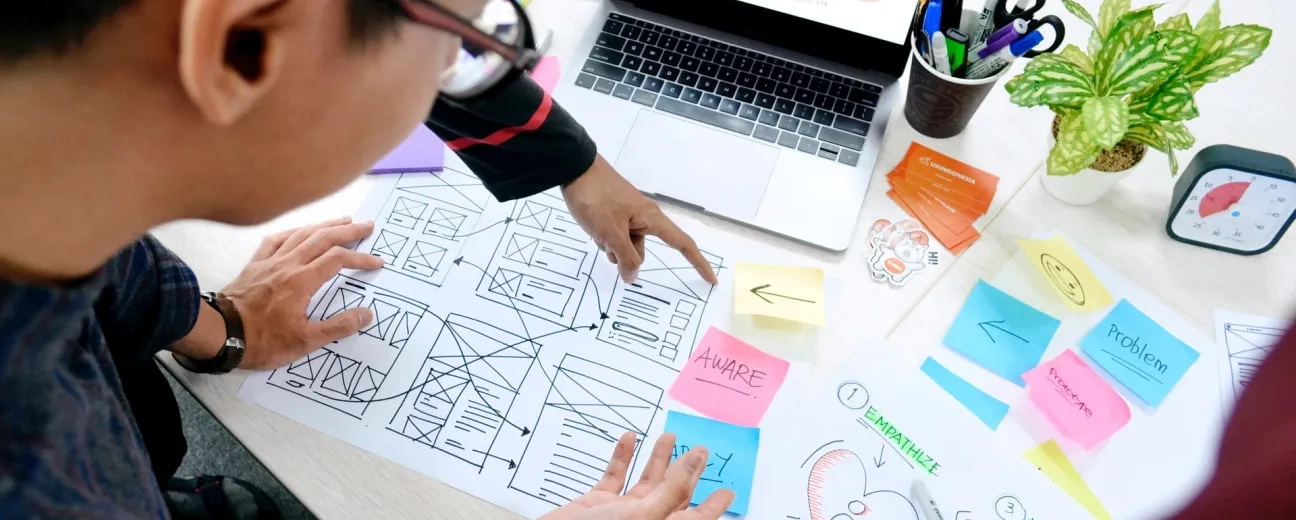
We’re excited to hear your project.
Let’s collaborate!

Websites and web applications are becoming increasingly complex, providing rich and interactive experiences. However, despite these emerging changes, the success of a website still relies on how the visitors perceive it. Is the website accessible and easy to use? Does it provide any value for me? Is it fun to navigate?
Your users' interaction with your website comes with these questions in mind, which build the foundation of their long-term decision to become regular customers.
UX is how a digital user feels when interacting with a website, web app, or software. Today, human-computer interaction should be accessible, efficient, provide value and utility for the user.
User experience design is a discipline that aims at meeting all these needs of the modern digital consumer by offering seamless web experiences.
User-centric business models are increasingly popular nowadays compared to how digital design was approached prior to the codification of user-centered design. Websites were built, and design decisions were made based on the preferences of the client and the designers' creative ideas.
The focus was on the brand and how the website looked, without considering what the users might feel when they would interact with the site.
However, as the Web is transforming at a fast pace—64.6 of the global population uses the internet today—and websites are becoming increasingly feature-rich, user experience designs are a must.
The design industry understands the need for optimization as users are interacting with web applications through multiple devices (mobile phones, tablets). Also, businesses also recognize accessibility as an essential requirement for modern digital users.
1. Evaluate your current system to learn about your website's current state, existing issues, and possible improvements.
2. Use A/B testing to compare and decide upon the effectiveness and reliability of different user interfaces.
3. Hold user surveys to find out what existing, and potential users of the system think about its design. Remember, the user experience is a subjective one, so what better way to collect insights about it than by interviewing the users?
4. Build user flows to outline how visitors move through your website. This enhances the ease of movement through your platform by ensuring that your users don't waste time looking at what to do next.
5. Develop wireframes and high-fidelity prototypes to convey the overall direction of the user interface.
6. Create design patterns to provide consistency and find the right user interface elements, like module tabs or slideshows, for specific tasks. By doing so, you'll be able to build improved, more familiar user experiences.
7. Do a content inventory so that you can enhance the user experience by changing your information architecture.
8. Get to know your audience, as this is an essential step for creating user-friendly website designs. Create user profiles and personas that support you in delivering experiences that reflect the needs and voice of your audience.
9. Create content style guides that provide UX designers and writers with the correct input for building consistent brand and design elements.
Identifying the areas where UX design would be of most benefit is important. While all Web systems could benefit from a design of the user experience, resources are not unlimited, and things need to be prioritized in the complex world of web development.
Complex systems with complicated architectures like multi-faceted websites, interaction-rich apps, or e-commerce sites can benefit a lot from UX design.
The same goes for start-ups and small companies, which can opt for training existing employees in the art of UX design to save some extra costs. However, creating solid user experiences in the first version of a product can generate more organic traffic and attract more visitors. But start-ups might not have enough resources for recruiting a highly-skilled UX designer.
UX design is also a good choice for projects with longer timeframes. Although UX design is not one size fits all, the concept can benefit long-term website projects by potentially saving time and costs.
Are you in doubt whether or not you need UX design or not? Don't worry, Optasy has your back. Contact us, and we'll do the hard work for you—analyze your website and offer advice and support on your UX design capabilities and opportunities. So let’s have a chat!
Photo credit: UX Indonesia on Unsplash.

We’re excited to hear your project.
Let’s collaborate!